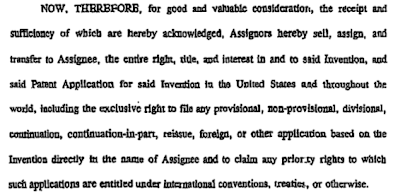Plaintiff AB Coaster Holdings Inc. claimed to be the owner of patents that were subject to terminal disclaimers. Some of the patents were expressly assigned and some were not. Here are the pairings:
‘633 (assigned) and ‘079 (not expressly assigned)
‘445 (not expressly assigned) and ‘263 (assigned)
‘079 (not expressly assigned) and ‘263 (assigned)
The defendant argued that since none of the pairs were fully transferred, and therefore the patents not co-owned, they were unenforceable.
The ‘633 patent was the parent and the other three above-listed patents, as well as another, the ‘134 patent, were all continuations-in-part of the ‘633. Here is the patent assignment language used for the ‘633:
If you can’t read the image, it says:
Assignors hereby sell, assign, and transfer to Assignee, the entire right, title, and interest in and to said Invention, and said Patent Application for said Invention in the United States and throughout the world, including the exclusive right to file any provisional, non-provisional, divisional, continuation, continuation-in-part, reissue, foreign, or other application based on the Invention directly in the name of Assignee and to claim any priority rights to which such applications are entitled under international conventions, treaties, or otherwise.
The continuations-in-part were all filed after the assignment of the parent.
The defendants challenged the plaintiff’s ownership of the child patents. The plaintiff claimed that the above language was an effective assignment of the child patents, but the defendants argued that the language–assigning “all right, title and interest to said Invention“–only assigned the original invention disclosed in the parent application and that any newly-added materials in the continuations-in-part would not have been assigned by the agreement.
The court found both arguments to be viable, so the court looked to extrinsic evidence to determine the intent of the parties. The defendant further pointed out that two continuations-in-part from the same parent, the ‘263 and the ‘134, were expressly assigned. If the above assignment of the ‘633 transferred ownership of all continuation-in-part applications, then the inventors would not have owned the ‘263 and ‘134 patents at the time they purportedly assigned them; rather, they would have already been owned by the plaintiff and the assignments were unnecessary. Thus the different treatment of the continuations-in-part indicated that the ‘633 assignment did not transfer any new inventive portion of a continuation-in-part.
But the defendant’s argument was made in a reply brief so the plaintiff had no opportunity to rebut it. The court therefore denied the motion and will consider evidence at an upcoming oral argument.
Hmmmm. I don’t know what to think of the argument. A winner or not? Was it sloppy assignment practice? If a continuation-in-part is subject to a terminal disclaimer, is there any new invention in it? Can you assign only a part of a patent that reflects an “invention,” not identified by claims?
AB Coaster Holdings, Inc. v. Greene, Nos. 2:10-CV-38, 2:10-CV-234 (S.D. Ohio Sept. 25, 2012).

The text of this work is licensed under a Creative Commons Attribution-No Derivative Works 3.0 United States License.


Leave a Reply